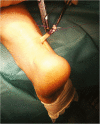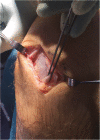Management of Achilles and patellar tendinopathy: what we know, what we can do
- PMID: 32993702
- PMCID: PMC7523300
- DOI: 10.1186/s13047-020-00418-8
Management of Achilles and patellar tendinopathy: what we know, what we can do
Abstract
Tendinopathies are challenging conditions frequent in athletes and in middle-aged overweight patients with no history of increased physical activity. The term "tendinopathy" refers to a clinical condition characterised by pain, swelling, and functional limitations of tendons and nearby structures, the effect of chronic failure of healing response. Tendinopathies give rise to significant morbidity, and, at present, only limited scientifically proven management modalities exist. Achilles and patellar tendons are among the most vulnerable tendons, and among the most frequent lower extremity overuse injuries. Achilles and patellar tendinopathies can be managed primarily conservatively, obtaining good results and clinical outcomes, but, when this approach fails, surgery should be considered. Several surgical procedures have been described for both conditions, and, if performed well, they lead to a relatively high rate of success with few complications. The purpose of this narrative review is to critically examine the recent available scientific literature to provide evidence-based opinions on these two common and troublesome conditions.
Keywords: Achilles Tendinopathy; Arthroscopy; Graft; Patellar tendinopathy; Tendinopathies; Tendon; Tenotomy.
Conflict of interest statement
The authors declare that they have no competing interest.
Figures





References
-
- Aicale R, Tarantino D, Maffulli N. Bio-Orthop. Berlin: Springer; 2017. Basic science of tendons; pp. 249–273.
Publication types
MeSH terms
LinkOut - more resources
Full Text Sources
Medical

